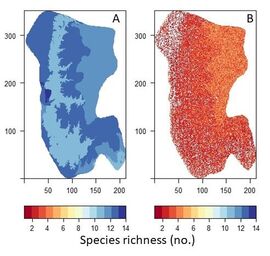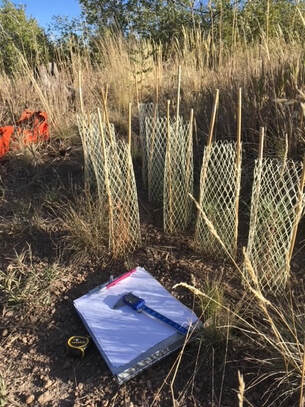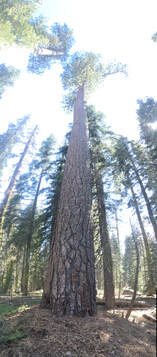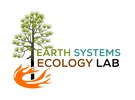 When modeling the past we start with the species evenly distributed because we don't know exactly where they were on the landscape thousands of years ago (left). We then simulate past climate and fire and let that work with elevation to force the species to sort across the landscape (right).
When modeling the past we start with the species evenly distributed because we don't know exactly where they were on the landscape thousands of years ago (left). We then simulate past climate and fire and let that work with elevation to force the species to sort across the landscape (right).
Past
We are working to understand how forest landscapes developed over time as a function of climate and disturbance changes. This work involves using tree rings to understand tree growth in the context of fire and climate in the recent past and using paleo-ecology data to inform ecosystem models to understanding forest dynamics over the distant past.
 Tree seedlings planted in the Las Conchas Fire footprint in northern New Mexico to understand the influence of amending the soil with biochar on survival.
Tree seedlings planted in the Las Conchas Fire footprint in northern New Mexico to understand the influence of amending the soil with biochar on survival.
Present
Our research on the current state of forest ecosystems is focused on understanding how restoring fire in dry conifer forests influences ecosystem function and resistance to forest cover loss from high-severity wildfire, especially in the context of ongoing climate change. We are also working in forests that have been burned by high-severity wildfire to better understanding how microclimatic variability influences tree seedling survival. Both of these research areas have management implications and we work to ensure the results are available to managers.
We are working to develop improved spatial data products to inform management and to better inform our ecosystem modeling efforts and their utility for informing management decision-making. We are working collaboratively with colleagues on the Santa Fe National Forest and from several conservation NGOs to accomplish this work and ensure the results meet the needs of the community.
Our research on the current state of forest ecosystems is focused on understanding how restoring fire in dry conifer forests influences ecosystem function and resistance to forest cover loss from high-severity wildfire, especially in the context of ongoing climate change. We are also working in forests that have been burned by high-severity wildfire to better understanding how microclimatic variability influences tree seedling survival. Both of these research areas have management implications and we work to ensure the results are available to managers.
We are working to develop improved spatial data products to inform management and to better inform our ecosystem modeling efforts and their utility for informing management decision-making. We are working collaboratively with colleagues on the Santa Fe National Forest and from several conservation NGOs to accomplish this work and ensure the results meet the needs of the community.

Future
Understanding how changing climate and disturbance conditions will alter the distribution of tree species and productivity of forests is an inherently future looking question. We use simulation modeling to work on this broad question from a number of different directions. Our simulation work also involves quantifying how the probability of high-severity fire changes as a function of changing climatic conditions and management. As we uncover source of uncertainty in the simulation environment, we use it to inform new empirical experiments that will iteratively improve our projects.
Understanding how changing climate and disturbance conditions will alter the distribution of tree species and productivity of forests is an inherently future looking question. We use simulation modeling to work on this broad question from a number of different directions. Our simulation work also involves quantifying how the probability of high-severity fire changes as a function of changing climatic conditions and management. As we uncover source of uncertainty in the simulation environment, we use it to inform new empirical experiments that will iteratively improve our projects.
